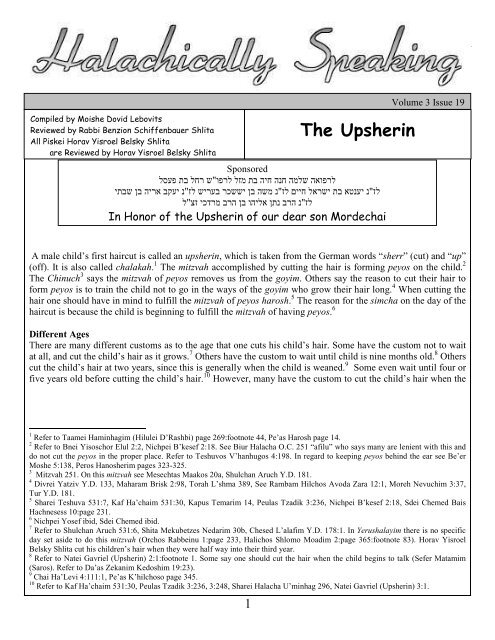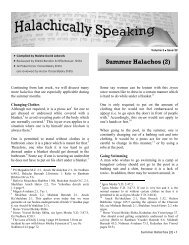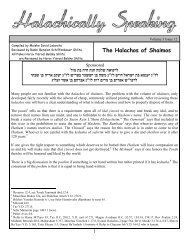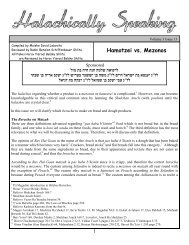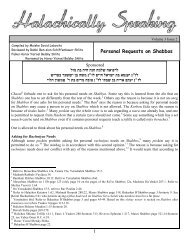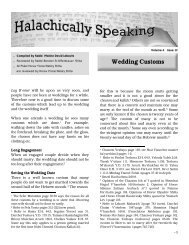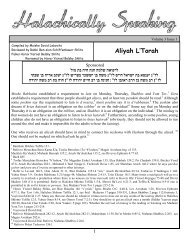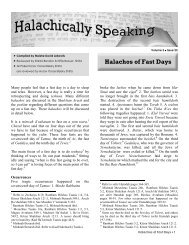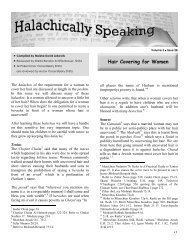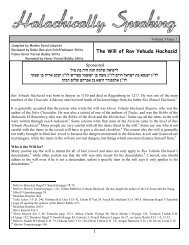The Upsherin - Halachically Speaking
The Upsherin - Halachically Speaking
The Upsherin - Halachically Speaking
Create successful ePaper yourself
Turn your PDF publications into a flip-book with our unique Google optimized e-Paper software.
<strong>Halachically</strong> <strong>Speaking</strong>Compiled by Moishe Dovid LebovitsReviewed by Rabbi Benzion Schiffenbauer ShlitaAll Piskei Horav Yisroel Belsky Shlitaare Reviewed by Horav Yisroel Belsky ShlitaSponsored<strong>The</strong> <strong>Upsherin</strong>לרפואה שלמה חנה חיה בת מזל לרפו" ש רחל בת פעסללז"נ יענטא בת ישראל חיים לז"נ משה בן יששכר בעריש לז" נ יעקב אריה בן שבתילז"נ הרב נתן אליהו בן הרב מרדכי זצ "לIn Honor of the <strong>Upsherin</strong> of our dear son MordechaiVolume 3 Issue 19A male child’s first haircut is called an upsherin, which is taken from the German words “sherr” (cut) and “up”(off). It is also called chalakah. 1 <strong>The</strong> mitzvah accomplished by cutting the hair is forming peyos on the child. 2<strong>The</strong> Chinuch 3 says the mitzvah of peyos removes us from the goyim. Others say the reason to cut their hair toform peyos is to train the child not to go in the ways of the goyim who grow their hair long. 4 When cutting thehair one should have in mind to fulfill the mitzvah of peyos harosh. 5 <strong>The</strong> reason for the simcha on the day of thehaircut is because the child is beginning to fulfill the mitzvah of having peyos. 6Different Ages<strong>The</strong>re are many different customs as to the age that one cuts his child’s hair. Some have the custom not to waitat all, and cut the child’s hair as it grows. 7 Others have the custom to wait until child is nine months old. 8 Otherscut the child’s hair at two years, since this is generally when the child is weaned. 9 Some even wait until four orfive years old before cutting the child’s hair. 10 However, many have the custom to cut the child’s hair when the1 Refer to Taamei Haminhagim (Hilulei D’Rashbi) page 269:footnote 44, Pe’as Harosh page 14.2 Refer to Bnei Yisoschor Elul 2:2, Nichpei B’kesef 2:18. See Biur Halacha O.C. 251 “afilu” who says many are lenient with this anddo not cut the peyos in the proper place. Refer to Teshuvos V’hanhugos 4:198. In regard to keeping peyos behind the ear see Be’erMoshe 5:138, Peros Hanosherim pages 323-325.3 Mitzvah 251. On this mitzvah see Mesechtas Maakos 20a, Shulchan Aruch Y.D. 181.4 Divrei Yatziv Y.D. 133, Maharam Brisk 2:98, Torah L’shma 389, See Rambam Hilchos Avoda Zara 12:1, Moreh Nevuchim 3:37,Tur Y.D. 181.5 Sharei Teshuva 531:7, Kaf Ha’chaim 531:30, Kapus Temarim 14, Peulas Tzadik 3:236, Nichpei B’kesef 2:18, Sdei Chemed BaisHachnesess 10:page 231.6 Nichpei Yosef ibid, Sdei Chemed ibid.7 Refer to Shulchan Aruch 531:6, Shita Mekubetzes Nedarim 30b, Chesed L’alafim Y.D. 178:1. In Yerushalayim there is no specificday set aside to do this mitzvah (Orchos Rabbeinu 1:page 233, Halichos Shlomo Moadim 2:page 365:footnote 83). Horav YisroelBelsky Shlita cut his children’s hair when they were half way into their third year.8 Refer to Natei Gavriel (<strong>Upsherin</strong>) 2:1:footnote 1. Some say one should cut the hair when the child begins to talk (Sefer Matamim(Saros). Refer to Da’as Zekanim Kedoshim 19:23).9 Chai Ha’Levi 4:111:1, Pe’as K’hilchoso page 345.10 Refer to Kaf Ha’chaim 531:30, Peulas Tzadik 3:236, 3:248, Sharei Halacha U’minhag 296, Natei Gavriel (<strong>Upsherin</strong>) 3:1.1
<strong>Halachically</strong> <strong>Speaking</strong>child reaches the age of three. 11 Some say the reason for this age is because just as the first three years of fruitsare off limits and the fruits of the fourth go to Hashem, a child is also “off limits” in his first three years since hecan not speak as well, and in the fourth year when he begins to speak he is dedicated to Hashem. 12Day or NightBased on the writings of the Arizal hair should not be cut after mincha gedolah. 13 Some say the reason for this isbecause we are scared one would forget to daven mincha. 14 At an upsherin this is usually not the case sincethere is a minyan made before or after the haircut. Others say the upsherin should be done in the morning. 15However, many Gedolim cut the hair of a child at night, 16 and in fact this seems to be the custom of manypeople. 17Cutting the Hair Earlier and Later<strong>The</strong>re is a discussion in the poskim if those who hold one makes the upsherin when the child turns three areallowed to make it earlier or later. Many say that one should only cut the hair on the day the child turns threeyears old. 18 <strong>The</strong> Chazzon Ish says making the upsherin earlier than it is supposed to be is not good for thesuccess of the child and does damage to him. 19 It would seem the reason is because you are making the childwear something when he is not ready for it, and it may cause him to hate mitzvahs. However, there are someposkim who maintain that one may make the upsherin earlier than the child’s third birthday. 20If the child’s hair is so long that it causes the child pain then one is permitted to cut the hair before the child’sthird birthday. 21When the day to cut the child’s hair falls out on Shabbos, the hair may be cut on Friday, 22 while others say thatit should be pushed off until Sunday. 23Where to make the <strong>Upsherin</strong><strong>The</strong>re is a discussion in the poskim if one is allowed to cut a child’s hair in a shul. Many say that doing so ispermitted, 24 while others hold it may not be done. 25 It would seem that if one will not be giving the child a11 Toras Yekose’al 47, Maharam Brisk 2:98-99, Minhag Yisroel Torah 493:16, Yisroel V’hazemanim 59, Chinuch Yisroel 8. Refer toGan Hamelech 62, Be’er Heitiv 531:7, Arugas Habosem O.C. 210, Sharei Halacha U’minhag 2:296, see Medrash Tanchuma toVayeira 22:3.12 Medrash Tanchuma Kedoshim 14:page 159 (new), Arugas Habosem ibid, see Shevet Ha’Levi 8:206 who does not agree with theArgas Habosem’s reasoning.13 Refer to Magen Avraham 255:5, Elya Rabbah 232:6, Birchei Yosef 232:3, Ben Ish Chai Vayikra 1:11, Moed Lechol Chai 6:7,Shulchan Hatohar 251:5, Melei D’chasidusa 57:pages 203-204, Taamei Haminhagim 255 (kuntres achron) page 122, Pela Yoetz(Giluach) page 106 (new).14 Poskim. Refer to Ben Ish Chai ibid.15 Chinuch Yisroel 8:page 242, Kotzosov Taltlaim page 43:footnote 26. Many do it after shacharis (Chinuch Yisroel page 509:11).16 Natei Gavriel (<strong>Upsherin</strong>) 1:5:footnote 10. If one is cutting the hair on Lag B‘omer it may be cut at night (Kotzosov Taltlaim pages54-55:footnote 51).17 Pe’as Harosh page 40:35.18 Arugas Habosem ibid, Toras Yekose’al 47, Aprakasisa D’yana 161, Sharei Halacha U’minhag ibid, Chinuch Yisroel 8:page 239(old), Pe’as Harosh page 15. One should not make it on Sunday only because that is when people are off from work (Chinuch Yisroel8:page 497:footnote 11 new).19 Quoted in Teshuvos V’hanhugos 2:246. One should not tell a child a scary things because it will damage the child (Noheg KatzonYosef (Limud) page 101, Be’er Moshe 8:97).20 Kotzosov Taltlaim page 38.21 Natei Gavriel (<strong>Upsherin</strong>) 2:4:footnote 6, Sheilas Rav 1:15:1.22 Chai Ha’Levi 4:111:4, V’yan Yosef 2:314, Chinuch Yisroel 8:page 499 (new).23 Refer to Chai Ha’Levi ibid.2
<strong>Halachically</strong> <strong>Speaking</strong>complete haircut one is permitted to do it in a shul even according to those who are stringent. 26 L’maseh, even ifone only cuts a little bit of hair it should not be done in shul. 27 If the upsherin must take place in shul it wouldbe better to perform the upsherin in the women’s section. 28Hundreds, if not thousands of people, cut their children’s hair in Meron on Lag B’omer, 29 as was the custom ofthe Arizal. 30 Some say the reason is so that the holiness of Rav Shimon Bar Yochai will be a zechus for thechild. 31 Others say the reason is because hair is part of the yetzer hara which was taught to us by Rav ShimonBar Yochai when he gave us the Zohar. 32 Many have the custom to go to Meron to cut a child’s hair even beforethe child turns three. 33 Others say one should only wait to go to Meron if the child was born during sefira. If thechild was born after Shavuos or before sefira then one should not go to Meron to cut his hair. 34On Thursday<strong>The</strong> Taz 35 is of the opinion that taking a haircut (or cut one nails) on Thursday is not an honor for Shabbos sincethe hair will grow on Shabbos. Many poskim argue with the Taz, and permit taking a haircut on Thursday. 36Accordingly, if the child’s birthday is on Thursday one is permitted to have the upsherin. 37Rosh ChodeshSome say if a child’s upsherin falls out on Rosh Chodesh one should push it off to a different day. 38Ben HashmushosA child who is born during ben hashmushos should have his upsherin the day after his birthday. 39 A child whowas born after shekia and before ben hashmushos should have his upsherin on his birthday. 4024 Shulchan Gevoah 531:13:2, Sdei Chemed Bais Hakenesses 10, Sdei Chemed Chol Hamoed 5:page 613, Kaf Ha’chaim 151:45,531:30, Kotzosov Taltlaim page 61:33:footnote 67, Vayivorech Dovid Y.D. 97:page 329, Tzedaka U’mishpat 12:9, Chinuch Yisroel8:pages 490-491 (new).25 Lev Chaim 2:172, Chinah D’chaya 55.26 Natei Gavriel (<strong>Upsherin</strong>) 8:4:footnote 9, Piskei Teshuvos 151:footnote 26.27 Horav Yisroel Belsky Shlita.28 Horav Yisroel Belsky Shlita, see Pe’as K’hilchoso page 352.29 Refer to Pardes Yosef Tazria 13:33, Minhagei Eretz Yisroel 23:13, Sharei Halacha U’minhag page 166, Chanoch L’nar 32:footnote4, Hakotton V’hilchosuv 1:23:4, Yalkut Yosef 5:pages 435-436, Natei Gavriel Pesach 3:page 316:8, Eyunei Halachos 1:page 457,Pe’as Harosh page 29. Some go on other days to Meron for this even not on Lag B’omer (Natei Gavriel Pesach 3:pages 312-315).Others go to the kever of Shmuel to cut the childs hair (Radvaz 2:608).30 Ateres Zekanim 493, Sefer Hatodah page 258, see ibid:page 259, Minchas Elazar 4:10, Divrei Yoel 27, Peros Noshrim page 328,Chinuch Yisroel 8:page 503 (new).31 Sdei Chemed Eretz Yisroel 6:page 7. Refer to Lag B’omer pages 313-314.32 Aprakasisa D’yana 1:161. Refer to Kotzosov Taltlaim page 60 for an additional reason.33 Ben Pesach L’Shavuos 19:13:footnote 20, Pe’as K’hilchoso page 347, Lag B’omer page 27:footnote 29, Chinuch Yisroel 8:page502:footnote 15 (new). Some say he can even be two and a half (Kotzosov Taltlaim page 39:footnote 16).34 Refer to Arugas Habosem O.C. 210, Aprakasisa D’yana 1:161, Chinuch Yisroel 8, Hakotton V’hilchosuv 1:23:7, TeshuvosV’hanhugos 2:246, Minhag Yisroel Torah 493:pages 351-353, Hilchos Yemei Ha’omer page 33.35 O.C. 260:1, see Elya Rabbah 5. Refer to Likras Shabbos 6:21. <strong>The</strong> above halacha does not apply to women (Shevet Ha’Levi6:21:2).36 Refer to Pri Megadim M.Z. 1, Shulchan Aruch Harav 2, and (kuntres achron) 1, Mishnah Berurah 5, Aruch Ha’shulchan 6, HalichosBas Yisroel 15:footnote 24, Kaf Ha’chaim 15, Chai Ha’Levi 4:111:4, see Nishmas Shabbos 1:158.37 Pe’as K’hilchoso page 345. Others are stringent (ibid:page 346:footnote 5), see Chinuch Yisroel 8:page 499.38 Kapos Temarim 14:page 151, Rivevos Ephraim 4:97:34, Sefer Rosh Chodesh 16:10:footnote 17 quoting the opinion of HoravShlomo Zalman Aurbach zt”l, Natei Gavriel (Usheirin) 11:1-5, Chut Shuni Shabbos 4:page 319, Shraga Hameir 8:74:2, Chai Ha’Levi4:11. Others are lenient (Maharam Brisk 2:99, Divrei Shalom 6:46). Some say it is only permitted if the upsherin day falls out on thefirst day of a two day Rosh Chodesh (Divrei Shalom ibid).39 Yisroel V’hazemanim 59:page 316 in the name of the Satmar Rebbe zt”l. Refer to Natei Gavriel (<strong>Upsherin</strong>) 1:3:footnote 6.40 Ibid, Kotzosov Taltlaim page 43:footnote 25.3
<strong>Halachically</strong> <strong>Speaking</strong>Chol HamoedA child who was born on Chol Hamoed may have his upsherin on Chol Hamoed. 41 If a child was born the lastdays of Yom Tov one may cut the child’s hair on Chol Hamoed if he so desires. 42Ben Hametzarim- <strong>The</strong> Three Weeks<strong>The</strong>re is a discussion in the poskim if a child born during the three weeks may have his hair cut during thistime. 43 <strong>The</strong> minhag seems to be that one can cut his hair unless it is the week of Tisha B’av. 44Who should cut the Hair?One should explain to the child what will be taking place during his haircut.It is proper for the father of the child to be present and cut the child’s hair since he is obligated in the mitzvah. 45<strong>The</strong> custom seems to be that the mother of the child does not cut the hair. 46 Many people have the custom to goaround to different tzadikim on the day the child’s hair is cut so the tzadik can cut off some hair. 47 Some saythere is no source for one to go to different tzadikim to cut the child’s hair. 48 One should invite relatives to cutthe hair. 49It is very important for the people who are cutting to know where and where not to cut, to make sure that theplace of the peyos is not cut in a forbidden manner. 50One should not take a haircut with a goyisha barber. 51 <strong>The</strong> reason is because we are concerned the goy may killhim. 52 If there is a mirror so one can watch the goy, 53 or there are other people present then it is permitted. 54Some say if the goy is getting paid it is permitted. 55 However, many say that based on reasons of kabbalah oneshould not take a haircut from a goy. 5641 Gan Hamelech ibid, Sharei Teshuva 531:2, Chinuch Yisroel 8:page 501:2. Some say the minhag is not like this (Halichos ShlomoMoadim 2:page 365:footnote 83).42 Apraksisa D’yana 161, Be’er Moshe 7:20:page 24, Mekadesh Yisroel 77.43 Refer to Toras Yekose’al 47:pages 78-79, Birchos Hashem O.C. 131:page 110.44 Toras Yekose’al 47:pages 78-79.45 Kotzosov Taltlaim page 62:footnote 68.46 Refer to Me’am Lo’ez Eikev page 573, see Kav Hayosher 72:page 362, Chinuch Yisroel 8:page 492:footnote 5 (new).47 Kotzosov Taltlaim page 63, Chinuch Yisroel 8:page 491:footnote 3 (new), Natei Gavriel (<strong>Upsherin</strong>) 7:2, Halichos Shlomo Moadim2:page 365:footnote 32.48 Teshuvos V’hanhugos 2:5, Orchos Rabbeinu 1:page 233:39.49 Kotzosov Taltlaim page 63:footnote 70, Pe’as Harosh page 21.50 Me’am Lo’ez Kedoshim page 227, Kotzosov Taltlaim page 63:36:footnote 71.51 Mesechtas Avoda Zara 27a, Shulchan Aruch Y.D. 156:1. <strong>The</strong> Shach 1 says this is only if one is using a razor. Refer to Taz 1. <strong>The</strong>Kaf Ha’chaim O.C. 260:13 says it is “good” that a goy does not cut a yid’s hair.52 Rashi Mesechtas Avoda Zara ibid “bechol makom,” Shach 1. Refer to Tammei Haminhagim Lekutim 9:page 495 who says it is inorder for us to avoid bowing down to a tzelem.53 Rama ibid.54 Shulchan Aruch Y.D. 156:1.55 Shach 2, Bais Lechem Yehuda 1. Some say if the goy is cheaper than the yid one can use the goy as a barber (Sheilas Shalom 94-95).56 Yufei Leleiv Y.D. 3:156, Yesod V’shoresh Hu’avoda 8:1:page 282, Bnei Yisoschor Shabosos 6:18, Pela Yoetz (Giluach) page 106(new). In a situation that no yid is available and one uses a goy to cut one’s hair, one should recite the posuk in Bereishis 1:27 (PelaYoetz Giluach ibid).4
<strong>Halachically</strong> <strong>Speaking</strong>A child who is getting his first haircut should not take it from a goy. 57 <strong>The</strong> Sdei Chemed says there is no simchaif the child’s hair is cut by a goy. 58 This is especially true since a child on the day of his upsherin is notsupposed to see a goy (as will be discussed later)..How to Begin CuttingBefore the hair is cut one should gather the peyos to make sure they are not accidentally cut. 59 Generally oneshould use scissors to cut. 60 Some people have the custom to start cutting in the place of the tefillin. 61Minhagim after the HaircutAfter one cuts hair he is obligated to wash his hands, 62 this is even if he is cutting someone else’s hair. 63 <strong>The</strong>reis a discussion in the poskim if one is required to wash his hands after cutting a child’s hair at an uphserin, sinceonly a little bit of hair is cut before going to a barber to cut the rest of the hair. 64 It would seem that the peoplewho only cut a little bit of the hair are not required to wash their hands afterwards. 65 <strong>The</strong> child himself shouldwash his hands after receiving his upsherin. 66What to do with the HairMany have the custom to place the cut hair in a bag before throwing it out. 67 One should not throw the cut hairon to the floor. 68 Some take the hair and see how much it is worth in gold and give that money to tzedaka, andthis is a segula that the child will be a talmid chachum. 69 Others place the hair in shaimos. 70<strong>The</strong> SimchaOne should make a party (and invite many guests) 71 to celebrate his being able to train his child in the mitzvahof peyos by being able to give him a upsherin. 72 One should also give shevach to Hashem for giving him thisopportunity. 73 If possible, the party should be made with music, etc. 74 Many have the custom to distributeschnapps and cake on the day one is zocheh to give his child an upsherin. 75 . 7657 Refer to Gan Hamelech 62, Darchei Teshuva 4, Sdei Chemed Chol Hamoed 5, Kotzosov Taltlaim page 64:footnote 72, Pe’asHarosh page 48:44, Natei Gavriel (<strong>Upsherin</strong>) 7:7:footnote 9.58 Mareches Chol Hamoed 5:page 12.59 Natei Gavriel (<strong>Upsherin</strong>) 5:3, Kotzosov Taltlaim page 64.60 Ibid.61 Chinuch Yisroel 8:page 242, Kotzosov Taltlaim page 65.62 Shulchan Aruch 4:19, Chinuch Yisroel page 514 (new). One may wash his hands in the barer shop, there is no reason to refrain fromdoing so (Rivevos Ephraim 1:7:3).63 Yufei Leleiv (Yosher Lelov) O.C. 4:18:page 180.64 Refer to Kotzosov Taltlaim pages 85-86:footnote 105.65 Teshuvos V’hanhugos 2:5, Shevet Ha’Kehusi 2:5, Natei Gavriel (<strong>Upsherin</strong>) 16:footnote 2, Halichos Shlomo Moadim 2:pages 364-365:footnote 32, and 84.66 Just as everyone else is obligated to do so when their hair is cut as expressed in Shulchan Aruch 4:18.67 Kotzosov Taltlaim page 87:footnote 110.68 Refer to Rashi in Yecheskel 5:3. One should not burn them (Sefer Matamim (Saros 2) page 173 new).69 Segulas Yisroel 3:25:page 51 (new), Kotzosov Taltlaim page 89.70 Yufei Leleiv O.C. 260:6, Da’as Torah 260:page 44.71 Peulas Tzadik 3:248.72 Refer to Machzor Vitrei 508:page 630, Sharei Teshuva 531:7, Nichpei Yosef 2:18, Peulas Tzadik 3:232, Sdei Chemed CholHamoed 5:page 13, Kapos Temarim 14.73 Kav Hayosher page 72, Me’am Lo’ez Eikeiv page 573.74 Nichpei Yosef and Sdei Chemed ibid.75 Maharam Brisk 2:98, Chai Ha’Levi 4:111:3, Peulas Tzadik 2:232, Kotzosov Taltlaim page 91.76 Peulas Tzadik 3:248.5
<strong>Halachically</strong> <strong>Speaking</strong>Wearing a YarmulkaWearing a yarmulka brings a person to fear Hashem, 77 and protects one from sinning. 78 <strong>The</strong> word yarmulka (inHebrew) stands for “yure malka” fear of the king. 79 Some poskim are of the opinion that a young child shouldwear a yarmulka even before his upsherin. 80 However, the custom of most people is for the child to beginwearing a yarmulka on the day he turns three, 81 even though the inyun of wearing a yarmulka is not related tothe inyun of an uphserin. <strong>The</strong>refore, if for some reason one does not cut the child’s hair on the day he turnsthree, the yarmulka should still be placed on the child. 82 One should train his child not to remove his yarmulkathroughout the day. 83Tzitzis<strong>The</strong> custom is that a child does not wear tzitzis until he turns three. 84Although the tzitzis have no connection to the yarmulka or the upsherin, they are still put on for the first timethe same day. 85 <strong>The</strong>refore, one who does not get his hair cut on his third birthday should still begin wearingtzitzis on that day. 86Going to ChederIt is customary that on the day the child’s hair is cut he is taken to cheder where a rebbe performs manydifferent customs. 87 Some say if for some reason the child’s hair is not cut on his third birthday he should stillbe brought to the cheder, 88 while others say this should not be done. 89<strong>The</strong> day the child goes to cheder is like the day the Torah was given to klal yisroel, 90 and one should choose arebbe who is a G-d fearing person. 91 Although the child may begin learning with a morah one should still go toa rebbe on the day of the upsherin. 9277 Mesechtas Shabbos 156b, Moreh Nevuchim 3:52, Divrei Torah 1:22.78 Shulchan Hatohar (Roth) 5:page 42.79 Masef Lechul Hamachanus 2:21.80 Magen Avraham 2:6, Levush Malchos page 106:3, Chai Ha’Levi 4:111:3.81 Hilulei D’Rashbi page 98, Devar Moshe 72:1.82 Levush Malchos page 108, Chinuch Yisroel 8:page 239, Natei Gavriel (<strong>Upsherin</strong>) 16:5:footnote 11. Refer to Levush Malchos page108:footnote 13 who brings those who argue and say if the child’s hair is not cut on his third birthday then he should not wear ayarmulka until his hair is cut.83 Shulchan Hatohar (Roth) 5:page 42.84 Elya Rabbah 17:3, Aruch Ha’shulchan 5, Shevet Mussar 31:12, Natei Gavriel (<strong>Upsherin</strong>) 16:1:footnote 6, Chinuch Yisroel 8:page494:footnote 7 (new). Refer to Pela Yoetz (Tzitzis) page 48b (old), V’yan Yosef 2:314:page 254, Natei Gavriel (<strong>Upsherin</strong>)16:2:footnote 7. Although based on the Arizal some have the custom to wear tzitzis to sleep, a young child does not have to (ShevetHa’Levi 8:163:4).85 Chinuch Yisroel 8:page 493:footnote 7 (new). Some say one should train his child from the beginning to keep the tzitzis out of hispants (Levush Malchos pages 122-126 in depth).86 Ibid.87 Maharam Brisk 2:98, Natei Gavriel (<strong>Upsherin</strong>) 19:1. A child should be bentched by the rebbe that he should grow up to be big inTorah (Sefer Matamim (Yoledes V’yuladim) 17:page 76 (new). One should not invite a rebbe to ones house, but one should go to acheder (Chinuch Yisroel 8:page 508 (new). One whose child is three on a day that the hair is not cut should learn with his son thealeph-bais with honey and go to cheder at the first possible time (Chinuch Yisroel 8:page 508 (new), see page 519:footnote 36). It isquestionable why we do not continue learning with a child the aleph-bais after three but come back to yeshiva at four years-old(Chinuch Yisroel 8:page 502:footnote 37 (new).88 Osios Machkimos pages 156-157:footnote 9, V’yan Yosef 2:314:footnote.89 Chinuch Yisroel 8.90 Mahzor Vitrei page 629, Kol Bo 74:page 312, Me’am Lo’ez Eikeiv page 572.91 Refer to Machzor Vitrei page 629, Kitzur Shulchan Aruch 165:10.92 Natei Gavriel (<strong>Upsherin</strong>) 18:13:footnote 17.6
<strong>Halachically</strong> <strong>Speaking</strong><strong>The</strong> day the child goes to cheder his hands should be washed netiylas yudayim. 93 <strong>The</strong> child should be cleanedfrom any dirt on his body, 94 and should be dressed in Shabbos clothes. 95Carrying the Child<strong>The</strong> custom is for the father to be the one to bring the child to cheder. 96 When going with the child to cheder thechild should be covered. 97 Although the seforim do not quote a custom to wrap a child in a tallis on the day hegoes to cheder, 98 the minhag is to cover him with a tallis. 99 <strong>The</strong> child is covered to ensure that he does not seeany impure things (such as a dog, horse, or goy) on the day of his upsherin 100 (if he goes to cheder that sameday). 101 <strong>The</strong> child should also be covered after he leaves the cheder. 102 Others have the custom only to cover thechild when he is going to cheder but not when he leaves. 103Seder of LearningAt the cheder the child should be put on the rebbes lap. 104 Using a luach with letters of the aleph bais written onit, 105 the rebbe should read each letter with the child repeating after him. 106 Some read the letters in the reverseorder starting with Tuf, Shin, Reish, Kuf. 107 A child who does not want to repeat after the rebbe does not have tobe forced to do so. 108 <strong>The</strong> rebbe should say Torah Tzivah Luno Moshe, 109 and Torah Teheiy Umnuseiy… 11093 Refer to Pri Megadim M.Z. 4:7, Shulchan Aruch Harav 4:2, Ben Ish Chai Toldos 1:10, Moreh B’etzbah 2:60, Mishnah Berurah4:10, Da’as Torah 4:2, Orchos Rabbeinu 1:page 14:15, 3:page 184:2, Teshuvos V’hanhugos 1:1, 2:1, Rivevos Ephraim 4:6, ShragaHameir 3:24:2, Minchas Gidiyon pages 108-109. Some say a child should wash his hands after awaking in the morning when he startswalking (Horav Yisroel Belsky Shlita). Others say when the child can take food by himself (Natei Gavriel (<strong>Upsherin</strong>) 16:footnote 22).Refer to Halichos Shlomo 20:footnote 25, Tzitz Eliezer 7:2-4. <strong>The</strong> Emes L’Yaakov 4:footnote 10 says the time to wash ones child’shands is when the child starts saying either Torah Tzivah etc, learn the aleph-bais, or when he starts to answer amen.93 Kotzosov Taltlaim page 87:footnote 110.94 Me’am Lo’ez Eikev page 572.95 Kol Bo 74:page 213, Me’am Lo’ez page 572.96 Kav Hayosher 72, Me’am Lo’ez ibid:page 572. Others say a chashuv person should carry him to the cheder (Machzor Vitrei page208:629, Kol Bo 74).97 Rokeach 296:page 164, Kol Bo 74, Kav Hayosher 72, Me’am Lo’ez Eikev page 572. This is true even if the father knows for a factthat the child will not see any un-pure things (Osisos Machkimos page 171:footnote 40).98 Refer to Machzor Vitrei 508:page 629, Kol Bo 74, Kav Hayosher 72, Me’am Lo’ez ibid page 572.99 Chai Ha’Levi 4:111:8, see Chinuch Yisroel 8:page 523 (new), Osisos Machkimos pages 168-169.100 Refer to Rokeach ibid, Kav Hayosher ibid:page 361, Me’am Lo’ez ibid, Chai Ha’Levi 4:111:8. See Chinuch Yisroel 8:pages 244-245. Some say a lady who is a niddah should not touch the child (Kav Hayosher 72:page 362, Me’am Lo’ez ibid:pages 572-573,Chinuch Yisroel 8:page 245) However, the custom seems to be lenient with this (Chai Ha’Levi 4:111:8). Even according to those whoare stringent it is only the day when the child is brought to the cheder, but if his hair is cut on a different day then there is no problem(Natei Gavriel (<strong>Upsherin</strong>) 20:10). <strong>The</strong> custom is that the child may look at a woman even if she is in her un-pure state. (ChinuchYisroel 8:page 245, Natei Gavriel (<strong>Upsherin</strong>) 20:6). <strong>The</strong> child should not look at a picture of an impure object either (Chinuch Yisroel8:page 524 new).101 Chinuch Yisroel 8:page 490 (new), Natei Gavriel (<strong>Upsherin</strong>) 20:10, Shevet Ha’Kehusi 4:336.102 Machzor Vitrei 508:page 629, Kav Hayosher 72:page 362, Me’am Lo’ez ibid:page 572, Chinuch Yisroel 8:page 526 (new).103 Chai Ha’Levi 4:111:8, Natei Gavriel (<strong>Upsherin</strong>) 20:3:footnote 8.104 Rokeach 296:page 164, Kav Hayosher 72, Me’am Lo’ez Eikev page 572.105 Machzor Vitrei 508:page 628, Rokeach 296:page 164, Kol Bo 74:page 312, Kav Hayosher 72, Sefer Matamim (YoledesV’yuladim) 17, Osios Machkimos page 132.106 Rokeach ibid, Kav Hayosher ibid, Me’am Lo’ez ibid, Minhag Yisroel Torah 2:page 357. Some teach the child the letters of thealeph bais when they begin to talk (G’ra Y.D. 245:19, Osisos Machkimos page 151, V’yan Yosef 2:314). This seem to be the customof most people, although the Rama (Y.D. 245:8. and others say that the child should be taught the letters of the aleph bais when he isthree years old. Refer to Taz 2, Me’am Loez ibid:page 573. One should teach it with a nigun (Natei Gavriel (<strong>Upsherin</strong>) 21:8.107 Kav Hayosher page 362.108 Refer to Osios Machkimos page 174, Chinuch Yisroel 8:page 522:footnote 22 (new). A child who does not understand how to saythe aleph-bais should be taught slowly if possible (Me’am Lo’ez Eikev page 573, Natei Gavriel (<strong>Upsherin</strong>) page 136).109 Mesechtas Succah 42a, Kav Hayosher 72:page 362.110 Osios Machkimos page 175.7
<strong>Halachically</strong> <strong>Speaking</strong>Some also say Hamalach Hagoel, 111 the first posuk of Krias Shema, 112 and the first posuk of ParshasVayikra. 113Even if the child’s hair was not cut on the day of his third birthday, he should still be taught the aforementionedpesukim. 114<strong>The</strong> rebbe should place honey on the letters and allow the child to lick the honey off of the letters. 115 Beforelicking the honey a shehakol should be recited on the honey. 116 <strong>The</strong> reason for licking the honey is a simon thatthe Torah should be as sweet as honey to the child. 117 Some put the honey only on the letters of aleph, mem andtuf (the letters of emes). 118 If one can’t find a luach or siddur with the aleph bais to read from, one may writethe letters on a piece of paper or on a blackboard. 119<strong>The</strong> Piece of CakeOne should bring a piece of cake to the child made from honey. This cake is eaten to open his heart to theTorah. 120 Some write pesukim on the piece of cake, 121 while others say this should not be done because one iserasing Torah. 122 Many poskim mention the inyun of eating the cake but do not mention writing pesukim onit. 123 It would seem that one should do whichever way he feels, however it seems most people do not have thecustom to place pesukim on the cake. 124EggSome mention the custom to give the child a boiled egg to open the child’s heart to the Torah. 125Candies<strong>The</strong> child should distribute bags of candies to the children in the cheder. 126111 Kav Hayosher in Kav Naki 72:26.112 Osios Machkimos page 176.113 Kav Hayosher 72:page 362, Kol Bo 74, Me’am Lo’ez ibid. Refer to Machzor Vitrei page 629, Me’am, Lo’ez Eikev page 73,Kitzur Shulchan Aruch 165:10, Chinuch Yisroel page 245, Minhag Yisroel Torah 2:page 357. Some say the reason is because thechild is becoming pure so we teach him about pure animals etc. (Kitzur Shulchan Aruch ibid, Sefer Matamim yoledes v’yelodim 19,21:pages 76-77).114 Chinuch Yisroel 8:page 244:footnote 9.115 Machzor Vitrei 508:page 628, Rokeach 296:page 164, Kav Hayosher 72, Me’am Lo’ez Eikev page 572.116 Osios Machkimos pages 179-180. Refer to Shulchan Aruch 202:8, Mishnah Berurah 204:50, Igros Moshe O.C. 1:63 regarding theberacha on honey.117 Machzor Vitrei ibid, Rokeach 296:page 164, Kav Hayosher 72, Me’am Lo’ez Eikev page 572, Sefer Matamim (YolodesV’yuladim) 17:page 76 (new).118 Minhag Yisroel Torah 2:page 257.119 Natei Gavriel (<strong>Upsherin</strong>) 21:16.120 Machzor Vitrei pages 628-629, Rokeach 296:page 164, Kol Bo 74, Me’am Lo’ez Eikev page 572. Some say if the child does notwant to eat the piece of cake he should be forced to eat it (Osios Machkimos page 188).121 Rokeach ibid.122 Opinion of Horav Elyashiv Shlita quoted in Giznei Hakodesh 11:19:footnote 30, page 265:62 quoting the opinion of Horav ChaimKanievesky Shlita, see Bais Yitzchok Y.D. 2:107, Chinuch Yisroel 8:page 244:footnote 10 (new).123 Refer to Kol Bo 74, Kav Hayosher 72, Me’am Lo’ez Eikev ibid, Chavos Yuer 16, Sheilas Yaavetz 2:140, Pri Ha’aretz 2:4, GinzeiHakodesh 11:19. Refer to Nishmas Shabbos 4:96.124 Natei Gavriel (<strong>Upsherin</strong>) 22:7:footnote 12.125 Mordechai Mesechtas Shabbos 7:369, Rokeach 296:page 164, Machzor Vitrei page 629. Refer to Osios Machkimos pages 191-192if one is allowed to leave this egg uncovered overnight.126 Me’am Lo’ez Eikev page 572, Chinuch Yisroel 8:page 528 (new), Osios Machkimos page 193:footnote 95. Refer to Kol Bo 74.8
<strong>Halachically</strong> <strong>Speaking</strong><strong>Halachically</strong> <strong>Speaking</strong> is a weekly publication compiled by Moishe Dovid Lebovits, chaver kollel of Kollel NachlasDovid in Yeshiva Torah Voda’as.Each week a different area of contemporary halacha is reviewed with an emphasis on practical applications of theprinciples discussed. Significant time is spent ensuring the inclusion of all relevant shittos on each topic, as well as thepsak of Horav Yisroel Belsky, shlit”a on current issues. Detailed footnotes are provided for further study.For a weekly email subscription to <strong>Halachically</strong> <strong>Speaking</strong>, please send your email address to mdl@thehalacha.com. Anominal fee will be charged. Weekly sponsorships are available, please call 718 744 4360.© Copyright 2007 Moishe Dovid Lebovits. All rights reserved.9


